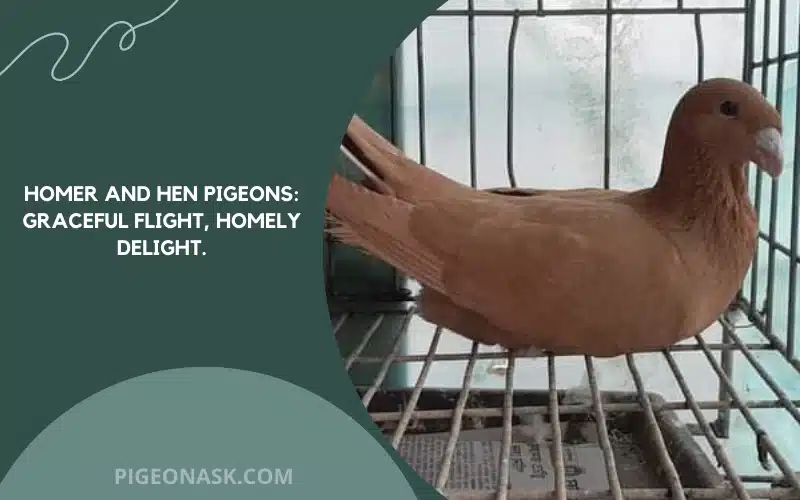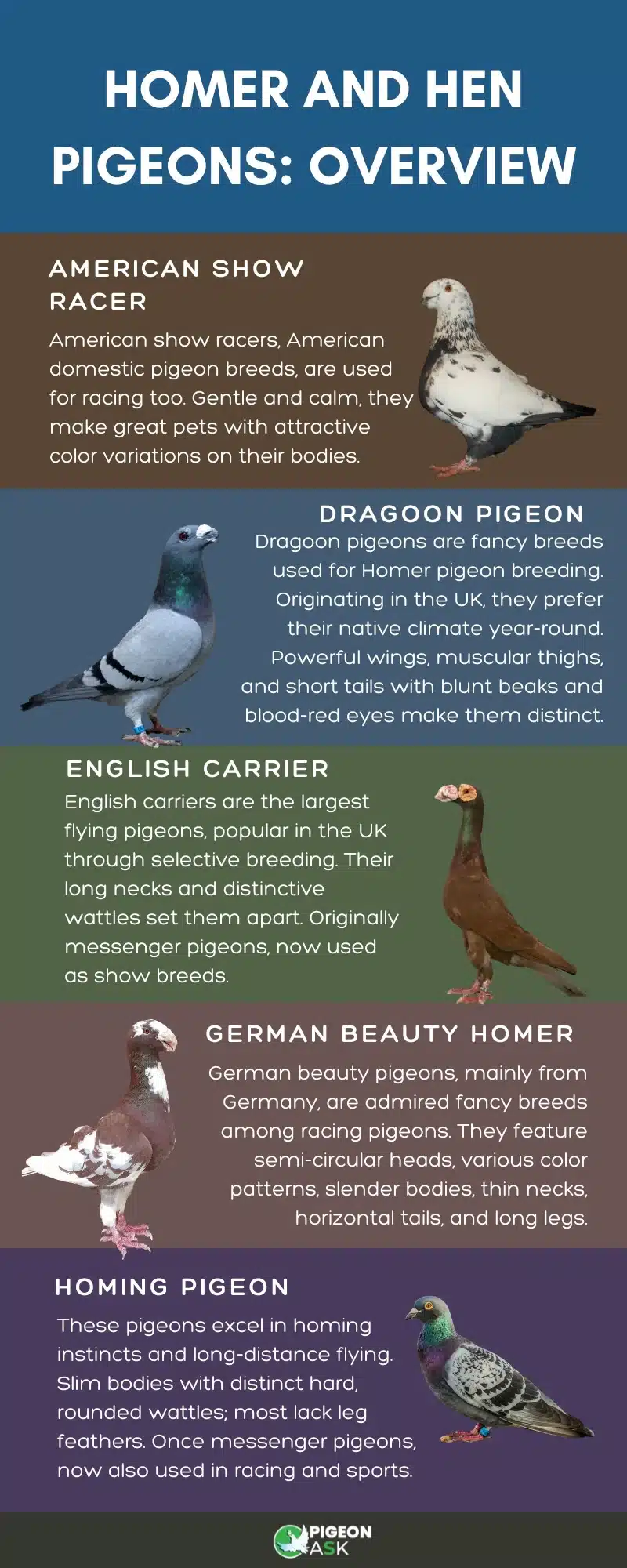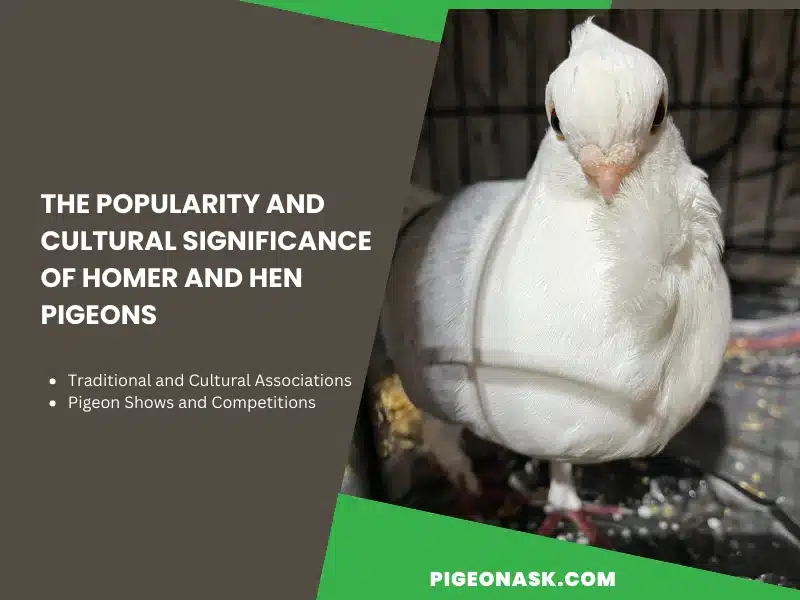Homer And Hen Pigeons: Behavior, Food And Habitat
Though we have seen people using pigeons as messengers, every variety of pigeons can’t deliver messages. Generally, Homer and hen pigeons are called messenger pigeons as they are mostly used as message carriers.
These pigeons have the ability to find their home or habitat even after flying to a far distance. For such a special characteristic, people for ages used homing pigeons to deliver letters to known destinations.
This article is all about the appearances, behavioral traits, eating habits and habitat of Homer and Hen pigeons so that you can have a detailed knowledge about them.

Overview of Homer and Hen Pigeons
Homer pigeons are generally called ‘Mail Pigeons’ and among them, the female ones are known as ‘Hen Pigeons’. They were first seen during the 19th century in Europe and since then, they have been produced by selective and mixed breeding.
These pigeons are called Homer pigeons because they have a unique homing instinct and can find their nesting places even after flying long distances.

Often people think of Homer pigeons as a specific breed, but actually, there are several breeds of these pigeons that are known as Homer and Hen pigeons.
Basically, pigeons of several breeds share some common characteristics and behavior that come under this category, including American Show Racer, Dragoon, English Carrier, German Beauty Homer, and Homing pigeon.
| Classification | Measurements |
|---|---|
| Scientific Name: Columba Livia Domestica | Length: 11-14 inches |
| Other Name: Mail pigeon, Messenger pigeon | Wingspan: 60-70 cm |
| Family: Racing Homer | Weight: 250-600 gm |
There are more than a hundred varieties of Homer and Hen pigeons around the world. Each of them has their individual characteristics and physical structures.
Some of the most popular and well-known ones are stated below.
American Show Racer
Though the American show racer is one of the American breeds of domestic pigeons, they are also used for racing purposes.
These pigeons have a gentle and calm nature that makes them pretty good as pets. Additionally, homers also have a beautiful and attractive appearance as there are a variety of colors on their body.
Dragoon
The dragoon is one of the fancy pigeon breeds that are used for the breeding of Homer pigeons. They have their main origin in different parts of the United Kingdom and like to live in their native climate all year round.
These pigeons have powerful wings, muscular thighs and short tails. Blunt beaks and blood-red-colored eyes make them unique among others.
English Carrier
Among all other flying pigeons, the English carriers are the largest ones. These pigeons have their natural habitat in the UK and are one of the most popular birds that are developed through selective breeding.
Their long neck and distinctive wattle make them different from other pigeon breeds. Though they are messenger pigeons, recently they are used as a show breed.
German Beauty Homer
The German beauty pigeons have their origin in a few countries of Europe, mainly in Germany. They belong to the breeds of fancy pigeons and are known as a form of beauty among other racing pigeons.
These pigeons have a distinctive semi-circular head along with several color patterns all over their body. They have slender bodies with thinner necks, horizontal tails and longer legs.
Homing pigeon
These pigeons are mostly known for their homing instincts and the ability to fly long distances. They have slim bodies with distinct hard and rounded wattle. Most of these pigeons don’t have any leg feathers.
Though they have been used as messenger pigeons since decades ago, nowadays, they are also used for racing and other sports purposes.
You can read our full article about “Homing pigeon breed“!
Looking for more articles about pigeon types:
Common Physical Appearance and Unique Features
Homer and Hen pigeons are usually medium-sized, strong birds with slim and slender bodies. They have a wide chest area, strong back and powerful muscles in their wings that help them to fly for a longer time.

Generally, the male Homer pigeons are a bit larger than the female ones and they sound very louder. These pigeons often carry a band on their legs that is used for tracking them. Their legs are kind of reddish with no feathers.
Larger wing lengths and thicker necks are some of the main structural differences between these pigeons and their other varieties. These pigeons have clear eyes with reddish Irish. They are known for the sparkle in their eyes that appear like stars.
Behavior and Personality
Homer and Hen pigeons are social birds and they usually live in flocks. Though they live with a large group by creating a community, their social structure is flexible and a strict hierarchy is maintained.
Generally, these pigeons maintain a fixed territory around their nest and act together to save their nest territory. The male pigeons show strong territorial behavior and sometimes are involved in small fights regarding this.
Vocalizations
Adult Homer pigeons often generate cooing sounds for their communication purposes.
But the younger ones can’t make the cooing sound. They are often seen making squeaking and whistling sounds to gain attention and seeking help from others.
If any trouble arises, the Homer and Hen pigeons sound like grunting by keeping their heads up. Generally, they make such a sound while being attacked or injured.
While mating, the pigeons often make sounds by moving their wings and feathers while keeping their heads up.
Diet
Different types of seeds and grains are the ultimate favorite food for these pigeons. They mostly love plant-based foods, but occasionally, they also eat meaty foods, including different types of small insects.
These plant-based diets are both tasty and healthy for the pigeons and contain almost every essential nutrient for maintaining their well-being.
The domestic ones often eat commercial foods that include a mix of several grains and seeds, such as millet, wheat, corn, and sunflower seeds.
Chunks of green veggies, fruits, additional vitamins, and minerals are often included in some commercial foods.
Lifespan
Homer and Hen pigeons generally can race for about five years and mostly live beyond that. Generally, a healthy Homer pigeon can live for 10 to 12 years; but it can vary depending on the environment and unwanted accidents.
The hen pigeons have a longer lifetime than the male pigeons and they can live on average for 15 years. But with healthy habitat and enough food supply, they can live longer than that.
Reproduction and Migration
The reproduction process of Homer pigeons is almost similar to the other breeds of pigeons. Generally, the female lays eggs after 8-12 days of mating and hatch after 15-18 days.
Young Homers are taken care of by the adult ones until they are capable of living alone and finding their own food.
Though Homer pigeons can fly to larger distances, they don’t migrate to other countries during winter. They can sustain in different weather conditions and, generally make their nests near moist areas and rocky cliffs.
The Popularity and Cultural Significance of Homer and Hen Pigeons
The widespread popularity of Homer pigeons stems from their extraordinary homing instincts, which enable them to navigate long distances and return to their origins with unmatched precision.

These pigeons not only captivate enthusiasts for their remarkable abilities but also hold profound cultural and religious significance transcending diverse groups and communities worldwide.
Traditional and Cultural Associations
Throughout history, Homer and Hen pigeons have adorned the annals of human civilization, revered as sacred beings in numerous traditional associations.
Their innate capacity to recognize and reconnect with their native habitats has positioned them symbolically as bearers of auspicious fortune and blessings, evoking reverence and admiration.
Pigeon Shows and Competitions
Having witnessed firsthand the captivating world of pigeon shows and competitions, I can attest to the extensive training and expertise required to prepare Homer and Hen pigeons for these thrilling events.
Their inherent agility and remarkable flying abilities make them coveted contenders in various racing competitions. The distance and speed of the competing pigeons are calculated after flying back to their starting location.
And the fastest flying pigeon is determined by using different timing measurement devices and the winner is declared based on the record of their arrival time.
Breeding and Care Tips for Homer and Hen Pigeons
While domesticating your pigeons, you should maintain proper guidelines to maintain them well and keep them healthy and happy. The following breeding and care tips will help you out doing so.
Proving Enough Space
During the breeding season, it is more than necessary for your pigeons to have larger space around them, whether for mating or laying eggs. So, try not to overcrowd their shelter and keep enough space for each of them.
You can also arrange separate spaces in the same housing for each pair of pigeons. It will help them to have an individual space for mating purposes.
Ensuring Proper Nutrition
It is required to provide energy-dense foods to your Homer and Hen pigeons during their breeding period. Because this particular period is crucial for them and being healthy can make mating and breeding easier and safer.
Provide them high calories and protein-dense foods, including seeds, nuts, barley, wheat and rice. Besides, you can also provide them with meaty protein like small insects and worms if they are habituated to such a meaty diet.
These would help them to develop energy for laying eggs and hatching them properly. Besides natural food, you can also give them high-quality commercial foods that contain essential vitamins and minerals.
Arranging Separate Nest Box
During the breeding season, you can arrange separate nest boxes inside your pigeon house so that the female pigeons can be comfortable while laying and hatching their eggs.
Nest boxes can keep the eggs warm and the female pigeon can stay cozy in the comfortable space. The female Homer can stay in the nest box even after the babies are born.
As the baby pigeons remain vulnerable for a few weeks after their birth, they can be protected from germs and outside weather complexities while being in the nest box.
Geographic Distribution of These Breeds in Asia
Though most of the breeds of Homer pigeons have their origin in different parts of the United States and the United Kingdom, there are some breeds from a few countries in Asia.
The habitat of Homing pigeons has increased dramatically in Central and Southeast Asia, India, Japan, China and Mongolia.
Their geographic distribution in Asia has changed over the years and they started living near the rainforests and swamp forests in these countries.
Closing Notes
Having firsthand experience with Homer and Hen pigeons, I can attest to their remarkable homing instincts and versatility as domesticated birds.
These pigeons possess a unique ability to find their way back home, making them ideal for messaging purposes and even participating in renowned sports activities.
As an enthusiast in the field, I have witnessed their distinctive characteristics and behaviors firsthand.
Given the growing popularity of pigeon breeding among bird enthusiasts, it is crucial to uncover their mysteries and appreciate their remarkable feats, leaving no doubt as to their capabilities.
Image Credits:
- Canva.com/photos
- https://www.facebook.com/anwar.pigeonloft.10/
- https://www.facebook.com/jess.lauzon.7
